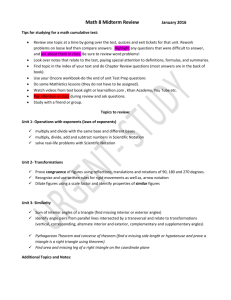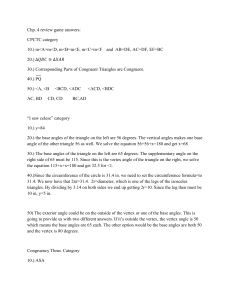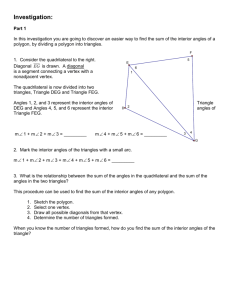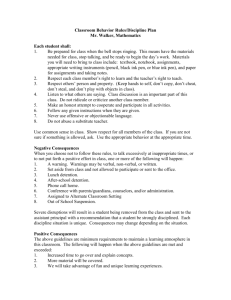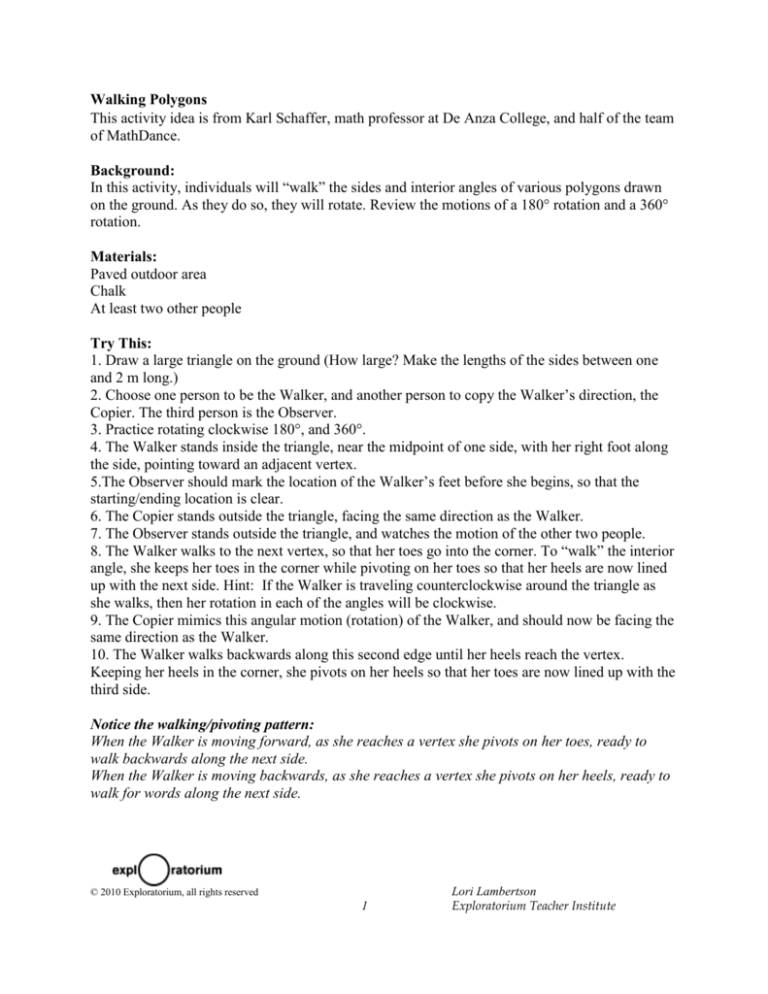
Walking Polygons
This activity idea is from Karl Schaffer, math professor at De Anza College, and half of the team
of MathDance.
Background:
In this activity, individuals will “walk” the sides and interior angles of various polygons drawn
on the ground. As they do so, they will rotate. Review the motions of a 180° rotation and a 360°
rotation.
Materials:
Paved outdoor area
Chalk
At least two other people
Try This:
1. Draw a large triangle on the ground (How large? Make the lengths of the sides between one
and 2 m long.)
2. Choose one person to be the Walker, and another person to copy the Walker’s direction, the
Copier. The third person is the Observer.
3. Practice rotating clockwise 180°, and 360°.
4. The Walker stands inside the triangle, near the midpoint of one side, with her right foot along
the side, pointing toward an adjacent vertex.
5.The Observer should mark the location of the Walker’s feet before she begins, so that the
starting/ending location is clear.
6. The Copier stands outside the triangle, facing the same direction as the Walker.
7. The Observer stands outside the triangle, and watches the motion of the other two people.
8. The Walker walks to the next vertex, so that her toes go into the corner. To “walk” the interior
angle, she keeps her toes in the corner while pivoting on her toes so that her heels are now lined
up with the next side. Hint: If the Walker is traveling counterclockwise around the triangle as
she walks, then her rotation in each of the angles will be clockwise.
9. The Copier mimics this angular motion (rotation) of the Walker, and should now be facing the
same direction as the Walker.
10. The Walker walks backwards along this second edge until her heels reach the vertex.
Keeping her heels in the corner, she pivots on her heels so that her toes are now lined up with the
third side.
Notice the walking/pivoting pattern:
When the Walker is moving forward, as she reaches a vertex she pivots on her toes, ready to
walk backwards along the next side.
When the Walker is moving backwards, as she reaches a vertex she pivots on her heels, ready to
walk for words along the next side.
© 2010 Exploratorium, all rights reserved
1
Lori Lambertson
Exploratorium Teacher Institute
11. The Copier mimics this angular motion (rotation) of the Walker, and should now be facing
the same direction as the Walker.
12. The Walker walks along the third side until she reaches the vertex in which she started. She
needs to complete her walk by “walking” the last angle. With her toes in the vertex, she pivots on
her toes so that her heels are now lined up the first side where she started. She should finish with
her feet in the location indicated by the starting chalk line. She may or may not be facing her
original direction.
13. The Copier mimics this angular motion (rotation) of the Walker, and should now be facing
the same direction as the Walker.
14. All players should confer about the total rotation after walking the interior angles of a
triangle. Walking around the triangle, turning in the interior angles, results in a 180° rotation.
The Walker and the Copier should be facing the opposite direction than the one in which they
started. Write “180°” inside the triangle.
15. Now draw a large quadrilateral on the ground.
16. Change roles, and have the Walker walk the interior angles of a quadrilateral.
17. After the Walker has returned to his starting vertex (and completed the rotation in the last
corner), confer about the total rotation for the quadrilateral. The Walker should be facing the
same direction in which he started. The sum of the interior angles of quadrilateral is 360°. Write
“360°” inside the quadrilateral.
18. Try walking the interior angles of a pentagon, and a hexagon. Do you see a pattern?
19. If you have time, see if this pattern is true for all triangles, all quadrilaterals, all pentagons,
etc.
Extension:
Choose one of the vertices in each of the polygons you have drawn on the playground, excluding
the triangle. From that vertex, draw diagonals to each of the other vertices. Doing this will make
each polygon into some number of triangles. Recall that the sum of the interior angles of any
triangle 180°. How does this way of observing each polygon’s interior angles relate to what you
noticed in Step 17?
What’s Going On?
There is pattern to the sum of the interior angles of any polygon. As the Observer noticed, the
Copier and the Walker both rotated through some multiple of 180° for each polygon measured.
The sum of the interior angles of a triangle is 180°, the sum of the interior angles of the
quadrilateral is 360°, and the sum of the interior angles of a pentagon is 540°. Draw a table on
the ground to record your data. Look for a pattern between the number of sides of the polygon
and the sum of its interior angles. There is a formula that describes this pattern: for any polygon
with n number of sides, the sum of the interior angles will be: 180° (n – 2).
© 2010 Exploratorium, all rights reserved
2
Lori Lambertson
Exploratorium Teacher Institute
© 2010 Exploratorium, all rights reserved
3
Lori Lambertson
Exploratorium Teacher Institute


